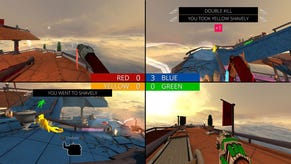The Stanley Parable calls shenanigans on narrative-driven design
The Stanley Parable isn't just another experiential, exploratory indie; it's a love letter to and a daring critique of a trend that has both liberated and bogged down gaming as a medium.
Where a narrative-driven game like BioShock: Infinite goes out of its way to make sure that the “psychopath” player cannot deviate from the developer’s intentions, The Stanley Parable joyfully embraces the fact that its players come to games to play – to fiddle around with interactions, to push the boundaries of what is possible, and to ask inconvenient questions like “why can’t I open this door?”
The Stanley Parable is a game that would not exist without a whole range of influential precursors. The one-time Half-life mod is a reaction against, commentary upon, critique and celebration of narrative-driven game design, specifically as it has existed since Valve created a place for narrative-driven first-person shooters.
With Half-Life, Valve popularised a then-rare kind of storytelling which has since proliferated and evolved; stories in which the narrative is built right into the heart of the game, happening around and to your character, rather than in cut-scenes and text slabs sandwiched between the action - and routinely skipped by bored players. This style of narrative is now found in games as diverse as Call of Duty: Ghosts and Beyond Two Souls, interspersed with more traditional cinematic-driven storytelling, and the medium is richer for it.
Narrative-driven games rely on the player doing what they're told to - pressing buttons on command - and that's less than ideal in a medium that differentiates itself on interactivity. The more you poke at these kinds of games, the more problems you find. The Stanley Parable pokes at them, relentlessly.
Where a game like BioShock: Infinite goes out of its way to make sure that the "psychopath" player cannot deviate from the developer's intentions, The Stanley Parable joyfully embraces the fact that its players come to games to play - to fiddle around with interactions, to push the boundaries of what is possible, and to ask inconvenient questions like "why can't I open this door?"
Doors that won't open are a real litmus test of how experienced a gamer is:
- Total beginner: hanging over your shoulder while you play a video game asking "why does that door open, but not any of the others?"
- Pretty clueless: insists on pressing the interact button in front of every door.
- Getting there: recognises at a glance which doors are textures or otherwise locked props and which are interactive objects.
- Veteran: becomes frustrated with newbies who complain about the fake doors because "that's how games work, geez".
- True veteran: jaded by games which consistently railroad the player, complains about the fake doors.
The Stanley Parable is loudly complaining about those doors. It's a perfect foregrounding of all the things developers normally want you to forget about games.
When designing a narrative-driven video game with voiceovers, timed events, and story progression linked to geographical progression, the designer is constantly challenged by the knowledge that the player - that bastard - doesn't always do what they're told. "Walk from A to B," the designer cajoles, "And I'll reward you with something to shoot, a bit of witty dialogue and a spectacular explosion."
They use all sorts of tricks to try to get players to obey the basic A to B imperative. Take a look at the lights in a non-linear environment; the correct path is usually brighter. Ambient events litter the most direct route. NPCs drift in the direction of the level goal. Rooms are shaped, ever so slightly, like rhombuses, to funnel you on. Some dude is constantly shouting in your earpiece that they're waiting for you at the pick up zone. They're waiting for you at the pick up zone, soldier. Soldier, they're waiting for you at the pick up zone. Your pick-up's waiting, soldiers; get to it. Don't keep the pick up waiting. They're waiting for you at the pick up zone.
Despite all this, players don't always do what they're told, do they? The flashing lights and sirens above the correct door pound out their message in vain; you're over in the corner, asking - what's down this path? Is there treasure here? Why are all these other rooms empty? Can I pick up this cup? Why can't I pick up this cup? How come I can pick up that cup? I wonder what happens if I throw the cup at an NPC? What happens if I do this? Oh hey if I run at precisely this angle I can clip right through the wall. What's over there? How did I get so lost?
This obstinate desire to explore and interact can be met in three ways. First, the developer can meet it head on, by providing outcomes for all the things the player might try. This is really, really hard, but very satisfying when it works. Unfortunately, it doesn't always work, and by providing realistic, non-linear environments and systemic interactivity, you're often leaving yourself open for players getting lost, breaking the game, and then complaining about bad design.
The second, much more easily-implemented solution is to shut down as many non-essential options as possible; you can't get lost in one corridor, and you can't trigger bizarre AI behaviour if there isn't any AI. Really good games tend to walk a line between the two, the third option, giving you limited freedom within a linear context, and hoping like hell you don't find something the testers missed.
In every case, the developer mostly wants you not to think about it. You're there to enjoy whatever the game's core mechanic is - usually combat or puzzles - and to listen to a story which somebody is very proud of, even if it was written in the last six months of a three year development cycle and hastily shoe-horned in around the level designer's quota of explosive set-pieces.
The Stanley Parable wants you to think about it. The Stanley Parable, despite its very limited inputs (you can't even jump, and very few objects are interactive) looks at those parts of first-person gaming that are least easy to design for - exploration and messing with the game's engine - and foregrounds them. It takes the very limitations of traditional gaming narratives and uses them to ruthlessly expose their own flaws.
The Stanley Parable has a wide collection of "endings", none of which are really the end - and players are still uncovering secrets. If you're the sort of person who pokes at things, you'll discover most of its content for yourself simply by keeping your eyes open and asking "what if I...?" Pitting your brain against the game, you may find yourself questioning aspects of design you've never even noticed before.
Afterwards, you won't be the same. Gaming won't be the same. And that's a good thing.
The Stanley Parable is available for PC on Steam for $15. A Mac version is on the way.










